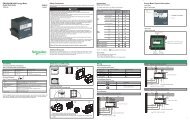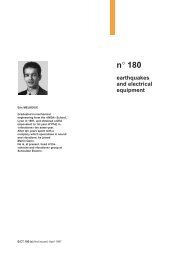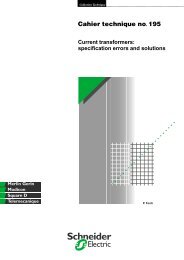Low Voltage circuit-breaker breaking techniques - Schneider Electric
Low Voltage circuit-breaker breaking techniques - Schneider Electric
Low Voltage circuit-breaker breaking techniques - Schneider Electric
- No tags were found...
You also want an ePaper? Increase the reach of your titles
YUMPU automatically turns print PDFs into web optimized ePapers that Google loves.
Since these <strong>circuit</strong>-<strong>breaker</strong>s are the main ones,their tripping is often delayed to obtaindiscrimination. They must therefore have a highelectrodynamic withstand, approaching the "20In" short-<strong>circuit</strong> values.c for devices needing to open and break quickly,enhance moving contact repulsion conditions inorder to obtain arcing voltage as quickly aspossible. A few diagrams are possible(see fig. 25 ):vwith simple repulsion loop,v with double repulsion (often created by a"double contact" ),v with "extractor", a magnetic core pushes orpulls the moving contact.The repulsion effects can be reinforced by theuse of magnetic <strong>circuit</strong>s:v with effects proportional to the current square:- U-shaped swallowing <strong>circuit</strong> (see fig. 26a ),- U-shaped expelling <strong>circuit</strong> (see fig. 26b ),aFrv with effects proportional to the current slope(di/dt), thus particularly effective on high currents(Isc), (cf. fig. 26c ).The arc chutesTheir main function is to maintain arcing voltageat a suitable value and absorb the energygenerated by the arc (this energy is sometimesphenomenal: if U a= 500 V and i = 10 000 A for2 ms, then Pa = 5 MW and Wa = 10 kJ!).The arc chute must also meet dielectricregeneration conditions sufficient to ensurepermanent <strong>breaking</strong> of the current, despitemains voltage presence.The physical phenomena to be considered for<strong>breaking</strong> are no longer solely electrical: thermalphenomena (melting, sublimation, evaporation)aerodynamics and radiation also play a role ineach instant's energy balances.Basically the arc chute sends the arc against anarc plate stack, arranged at right angles to themain arc column in order to:c split the arc up into the same number ofelementary arcs as there are intervals(see fig. 27a ), each of them thus generating aminimum arcing voltage due to the anode/cathode phenomenon and to its elongation.iFmiaFm,,,,,openingFmiibiciextractorFmFmFig. 25: contact repulsion principle:a: with simple repulsion loop;b: with double repulsion (often created by a "doublecontact");c: with "extractor", a magnetic core pushes or pulls themoving contact.iiiibci,,,,,,Fmopeningi2,,,,,,,FmFmFig. 26: magnetic contact repulsion devices:a: U-shaped swallowing <strong>circuit</strong> ;b: U-shaped expelling <strong>circuit</strong> ;c: repulsion with high di/dt.i2iopeningiiCahier Technique <strong>Schneider</strong> <strong>Electric</strong> no. 154 / p.22
















